“There must be a better way than this!” Jane muttered as she shuffled forward with all the other budget airline passengers. “After all it’s only a two hour flight, so why not make it just that little bit more comfortable, and not treat us like cattle?” Jane knew that it was a hackneyed expression, but said it anyway. It amused her as she thought of different names, such as Moove-over airlines, for the not so discerning traveller, and, Stampede Express, for the tourist who gets caught up in the rush. Jane must have laughed out loud as several enquiring and accusing faces glowered back at her. She could see them looking and shaking their heads in disbelief as she snorted with laughter! “Piggy Airlines, oink, oink, no free grub here!”
By now she was in convulsions, and only managed to stop when an over watchful security guard walked by and stared at her. “Threat to security too am I? Didn’t know that no frills meant no giggles too, oink, oink!” But, discretion being the better part of valour she shut up for fear of being kicked off the flight. The plane finally took off forty minutes late, with the pilot cheerily telling everybody, they would make up the time en-route. “Now sit back, relax, and enjoy the flight.” Jane would have liked to have done so but found herself wedged in between two rather large people, who, as it turned out were travelling together. Jane thought. “Why on earth don’t they sit next to each other?” So she asked the lady if they would like to change places. “Oh no! We were on first, and this is where we stay, thank you very much. Besides Ronny has to have the aisle seat, as he always gets air sick!” Jane shuddered at the thought, and to try and take her mind off what might happen she began to read. But as soon as the seat belt sign went off, ‘Mrs Ron’ needed to use the toilet! It seemed to take ages for all three to get unwedged from their seats and in the scramble Jane’s book got trampled on, tearing its cover, and scattering several pages under the row in front.
Finally ‘Mrs Ron’ was free. But, just as she started down the aisle, the seat belt light went back on. The flight attendant, who looked about twelve, but with the authority of a sergeant major, commanded ‘Mrs Ron’ to return to her seat, ‘for her own safety, as we are about to come into some turbulence.’ Hastily ‘Mrs Ron’ did as she was told, but on her way back to her seat, managed to reduce the remainder of Jane’s book into a mass of unreadable waste paper. Jane gave a mirthless grin, and sighed, “at last, real pulp fiction!” as she closed her eyes to try to shut out her predicament. No chance there though! Just as she began to doze off, Jane got an elbow in her ribs. She woke with a start to see Mrs Ron delving into a large bag. Jane watched with interest as she rummaged deep into its seemingly bottomless interior, finally producing a foil pack that was literally bursting open with food. Mrs Ron leaned over Jane. “Pilchard and sweet corn sandwich first Ron?”
Jane groaned as Ron reached over, clammily grabbing the strong smelling sandwich, and devouring it in three big bites! “Mmmm, that was good,” he mumbled, “what’s next?” Mrs Ron passed him a large flaky sausage roll, which he proceeded to eat in the same fashion, that was until he inhaled a crumb, and began to cough violently, and in all directions at once! Jane got her share, and so did the man across the aisle, but as he was sleeping didn’t notice his newly decorated arm. Jane just sat there, unable to move, because Mrs Ron was leaning over her fussing around with tissues. “There, there, dear, shouldn’t bolt your food, that’ll teach you not to be so greedy.” Just then the pilot’s voice came over the intercom. “Good afternoon ladies and gentlemen, we hope that you’re all enjoying the flight, you’ll be very pleased to know we’ve made up the forty minute delay, caused by congestion over Paris, and now we’re ahead of schedule, and should be landing in approximately thirty minutes. The weather in Barcelona is sunny and the temperature is 21�Celsius. If you look out of the windows you’ll see a lovely view of Southern France and the Alps, but please remain seated as there are some thunder storms ahead and we may experience slight turbulence, but there is nothing to worry about so please sit back, relax, and enjoy the flight” Jane groaned. “That’s about the last thing I can do, I just want to get off, things can’t get any worse than this, I hate it!”
But she spoke too soon. Ronny leaned over to his wife and announced he felt ill! He reached for the sick bag, just in time, and it was all Jane could do to stop herself from copying him. But she held her breath, and her resolve, until slowly the nausea passed. This didn’t stop ‘Mrs Ron’s’ panic as she proffered more tissues to her ailing husband. Luckily the flight attendant was on hand with a damp cloth, and a replacement bag. For the rest of the flight a very pale looking Ronny sat there, seemingly glued to his seat, with the sick bag and damp cloth clamped firmly to his face. When they finally touched down, Jane breathed a sigh of relief, but all to soon. because no sooner had the plane come to a standstill Mrs Ron was up and trying to clamber over her to help her husband. The damp cloth landed on Jane’s lap, and the sick bag dropped onto the floor under her feet. It was awful, her worst nightmare come true. But Jane’s inscrutability stayed constant. Only a few more minutes and they’d be out of her life forever, or so she thought!
Jane hadn’t realised that the airport was about 90km from Barcelona, at least another two hours journey. She’d planned to meet up with her friend Helen in time for lunch, and would have liked the chance for a shower beforehand, but by the time the bus was destined to arrive there it would be mid afternoon. “Nothing I can do about it anyway” Jane shrugged, as she bought her bus ticket. “I may as well sit out in the sun ’til its time to leave” She propped her shoulder bag against a tree, and, using it as a pillow, closed her eyes, breathed in the airport aroma of aviation fuel, tobacco, and coffee, and listened to the sounds of activity all around her. The constant gentle drone began to relax her and she started to regain her composure from the flight when she heard it! She sat up straight and looked. There they were, “The two Ronnies” pushing an overloaded baggage cart towards the bus. Jane watched as the driver, who had been sitting on a bench smoking and reading his paper, slowly get up to help them with their luggage. From his gaze Jane could already see his contempt for them building up as they neared him. He helped them to stow their cases and watched as they climbed up into the hot and stuffy bus. They collapsed into opposite seats and began fanning themselves with newspapers.
Presently the driver started the bus to get the air conditioning going, and slowly it began to fill up. But Jane, being a ‘super-cool’ independent traveller remained sitting in the sun until the last minute! The driver signalled to her that he was about to leave, and to get on board. Jane stamped her ticket and found a seat, well away from the two Ronnies. The driver began to check the tickets and as he made his way towards the back of the bus she heard a familiar voice. “Two tickets please.” She listened as the driver explained :”You must buy your tickets in the airport building but please hurry as we are going now!” The two Ronnies barged their way off the bus, making a lot of fuss and complaining loudly. Finally, just as the driver was about to remove their luggage, they returned looking rather hot and flustered. Jane began to feel sorry for them, as they seemed very dejected and forlorn. But, her sorrow was short lived as they plonked themselves down heavily in the only empty available seat, right behind her!
Eventually they arrived in Barcelona and Jane got to meet up with Helen. Over a drink at a pavement caf� she began to recount her journey, the crush to get on the flight, the cramped conditions, her neighbours eating habits, and finally the long bus ride to Barcelona. Helen stared at Jane in disbelief. “That must have been pretty uncomfortable Jane, but I’m surprised at you. We’ve been friends ever since junior school, and I always thought that you had an eye for a bargain!” Jane stared at her. “What do you mean? I got here for less then �70!” Helen laughed. “Plus your food, plus the bus fare, plus no choice of seat, plus the crush to get a decent place, plus the hassle of cramped claustrophobic conditions. I reckon you must have parted with at least �100 to get here. Need I say more?” Jane splutteringly tried to justify herself. “OK Helen, how did you get here then, by magic carpet?” Helen smiled sweetly back at her. “I booked my British Airways ticket on line, it cost me �90.00 all in, I got the seat that I wanted, and a snack on the flight. Plus they fly directly into Barcelona, and not some distant airport. By travelling my way I got here quicker and have more time to do everything I want to! Taking all your extra costs in to consideration I reckon I got the better deal don’t you?” Jane pondered for a moment, but had to reluctantly agree, and as she mockingly poked out her tongue she replied. “OK, smarty-pants, you’re right, I think I’ve learned my lesson. The cheapest deal isn’t always the best. Next time, before I press the ‘accept’ key on my computer, I’ll do some research and check out all of the options including Thomas Cook. Now, come on! Finish your drink, and lets get sight seeing. There’s so much I want to see. Besides, see those two people hovering at the entrance?”
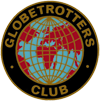
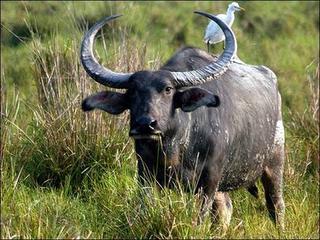
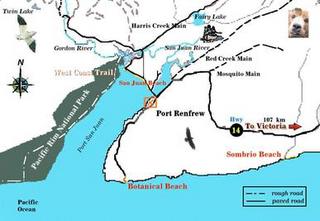 Port Renfrew is a small Canadian town with a major fishing problem. The problem is the sport fishing is great and only a few people know that. We arrive in Port Renfrew in late afternoon. Captain Quigley greets us at the entrance to Osprey Cabins. Quigley and his family provide these comfortable cabins in a beautiful rural setting – and there’s an outdoor hot tub to boot!
Port Renfrew is a small Canadian town with a major fishing problem. The problem is the sport fishing is great and only a few people know that. We arrive in Port Renfrew in late afternoon. Captain Quigley greets us at the entrance to Osprey Cabins. Quigley and his family provide these comfortable cabins in a beautiful rural setting – and there’s an outdoor hot tub to boot! 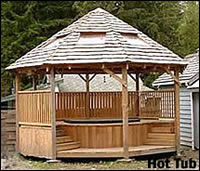 Their place is one of the most popular accommodations in Port Renfrew, and their rates are very reasonable.
Their place is one of the most popular accommodations in Port Renfrew, and their rates are very reasonable.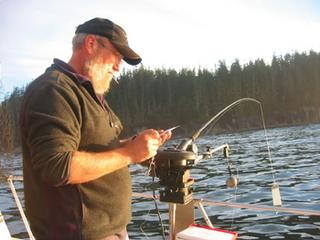 The first one I catch is a screamer! They call it that because it grabs the bait and takes off. The line literally ‘screams’ as the fish runs. Quigley knows what to do. He puts the boat in gear and chases the fish. My eyes almost pop when I look down at the reel and there are only about 3 wraps of line left! In seconds, the fish has run almost 300 yards of line. I reel as fast as I can until the line’s tight again and the fight’s back on. Non-stop excitement, boats all around us are getting strike after strike. On Quigley’s radio, we can hear the guides sharing information about their catches – “Double strike, 40 feet down!” They all share their success so everyone else can succeed too. Even when there’s a lull, and the fish aren’t biting, Captain Quigley is entertaining us. He teaches us his latest fish-luring chant and the accompanying dance: “Chinook, Chinook – Bite on my hook, my hook!” There’s never a dull moment on board. And when the fish are biting, Quigley is a very patient teacher: “Let him run! That’s it?? He’s got the whole boat to play with. Let him tire himself out??”
The first one I catch is a screamer! They call it that because it grabs the bait and takes off. The line literally ‘screams’ as the fish runs. Quigley knows what to do. He puts the boat in gear and chases the fish. My eyes almost pop when I look down at the reel and there are only about 3 wraps of line left! In seconds, the fish has run almost 300 yards of line. I reel as fast as I can until the line’s tight again and the fight’s back on. Non-stop excitement, boats all around us are getting strike after strike. On Quigley’s radio, we can hear the guides sharing information about their catches – “Double strike, 40 feet down!” They all share their success so everyone else can succeed too. Even when there’s a lull, and the fish aren’t biting, Captain Quigley is entertaining us. He teaches us his latest fish-luring chant and the accompanying dance: “Chinook, Chinook – Bite on my hook, my hook!” There’s never a dull moment on board. And when the fish are biting, Quigley is a very patient teacher: “Let him run! That’s it?? He’s got the whole boat to play with. Let him tire himself out??”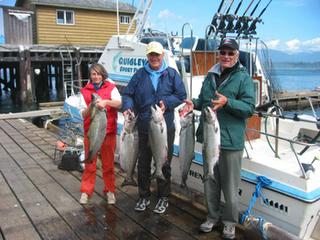 Later, Quigley tells us a story about the biggest fish ever landed on his boat. He had taken an elderly couple on an expedition, and it was turning out to be a disappointingly uneventful day – not one bite! Until they decided to turn back??. Then, all of a sudden, they got a nibble. It was a huge struggle, but with Quigley’s help, they reeled it in – a 52 pounder! Now that’s a really big salmon. It went on to win several categories in the fishing derby. We catch our limit long before the charter’s over, each fish is in the twenty-pound range. We had about 100lbs of fish on board, enough to feed us all winter! (We were fishing for spring salmon as the Coho and Sockeye fisheries were temporarily closed.) When I made dinner that night, back in Victoria, one fillet filled the grill on my barbeque! Five people dug in and there was 2/3 left over! We’re talking serious salmon here, folks! Small town, big fishing problem – right? Now you know.
Later, Quigley tells us a story about the biggest fish ever landed on his boat. He had taken an elderly couple on an expedition, and it was turning out to be a disappointingly uneventful day – not one bite! Until they decided to turn back??. Then, all of a sudden, they got a nibble. It was a huge struggle, but with Quigley’s help, they reeled it in – a 52 pounder! Now that’s a really big salmon. It went on to win several categories in the fishing derby. We catch our limit long before the charter’s over, each fish is in the twenty-pound range. We had about 100lbs of fish on board, enough to feed us all winter! (We were fishing for spring salmon as the Coho and Sockeye fisheries were temporarily closed.) When I made dinner that night, back in Victoria, one fillet filled the grill on my barbeque! Five people dug in and there was 2/3 left over! We’re talking serious salmon here, folks! Small town, big fishing problem – right? Now you know.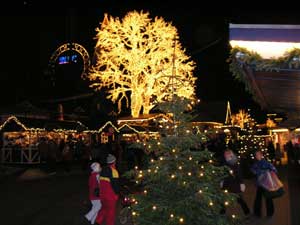 All the 3 million promised fairy lights were white and most of them draped around every branch of the trees, which made them look surreal. It was tasteful commercialism. The park was full of families, the kids excitedly queuing up for a ride in the reindeer drawn sleigh and toddlers practising their ski moves on the gentle nursery slope. There were braziers dotted around the park, in case you felt in need of quick heat or had some nuts to roast. The log cabin craft stalls sold all sorts of food, drink, gifts and homeware. It was very cold and windy, making me glad that I’d packed my thermal underwear.
All the 3 million promised fairy lights were white and most of them draped around every branch of the trees, which made them look surreal. It was tasteful commercialism. The park was full of families, the kids excitedly queuing up for a ride in the reindeer drawn sleigh and toddlers practising their ski moves on the gentle nursery slope. There were braziers dotted around the park, in case you felt in need of quick heat or had some nuts to roast. The log cabin craft stalls sold all sorts of food, drink, gifts and homeware. It was very cold and windy, making me glad that I’d packed my thermal underwear.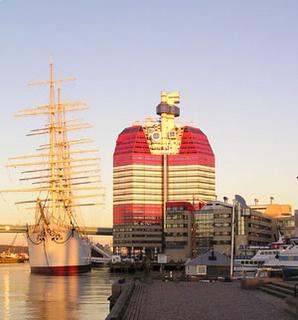 Then it was off the quayside to see the new Opera House and the sunset from the top of the Goteborgsutkiken (nicknamed the Lipstick). I also wanted to visit the Viking Barken, now used as a hotel-restaurant, and have a look at the cabins/rooms on board. There were 2 and 4 berth bunk bed cabins with shared bathroom facilities, or larger ensuite cabins. However, the lipstick viewpoint/cafe is only open during the summer. Anyway, I was keen to visit the City Museum, which closed at 5pm. The museum houses most of the wreck of a Viking longboat. There is a modern recreation of the boat hanging above, which gives you a more accurate idea of the dimensions. One of my favourite films as a child was a romantic adventure film about Vikings, starring Kirk Douglas. There were some Electrolux cylinder cleaners on display, and seeing things that you recall as household items as a child in a museum was rather disconcerting! There was a room featuring a Jubilee exhibition in Gothenburg during the Twenties. One of the reasons for the exhibition was to show Sweden’s industrial might. It also looked as though there was plenty of entertainment, and there was even a cr�che where you could leave the kids for the day.
Then it was off the quayside to see the new Opera House and the sunset from the top of the Goteborgsutkiken (nicknamed the Lipstick). I also wanted to visit the Viking Barken, now used as a hotel-restaurant, and have a look at the cabins/rooms on board. There were 2 and 4 berth bunk bed cabins with shared bathroom facilities, or larger ensuite cabins. However, the lipstick viewpoint/cafe is only open during the summer. Anyway, I was keen to visit the City Museum, which closed at 5pm. The museum houses most of the wreck of a Viking longboat. There is a modern recreation of the boat hanging above, which gives you a more accurate idea of the dimensions. One of my favourite films as a child was a romantic adventure film about Vikings, starring Kirk Douglas. There were some Electrolux cylinder cleaners on display, and seeing things that you recall as household items as a child in a museum was rather disconcerting! There was a room featuring a Jubilee exhibition in Gothenburg during the Twenties. One of the reasons for the exhibition was to show Sweden’s industrial might. It also looked as though there was plenty of entertainment, and there was even a cr�che where you could leave the kids for the day.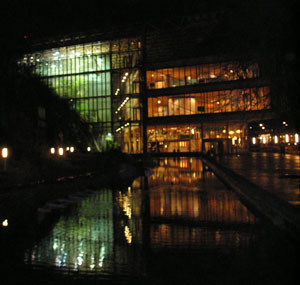 the science discovery centre. it was very imaginatively designed, with a recreated rainforest on several levels and a recreated Swedish landscape from mountain top to the seashore and below. There were also several floors of hands on activities. You could drive a Volvo lorry, design a model and get into nuclear physics (if so inclined). I couldn’t even manage to get 2 racing car models going with binary code! There are plenty of young enthusiastic multilingual guides at hand to explain things.
the science discovery centre. it was very imaginatively designed, with a recreated rainforest on several levels and a recreated Swedish landscape from mountain top to the seashore and below. There were also several floors of hands on activities. You could drive a Volvo lorry, design a model and get into nuclear physics (if so inclined). I couldn’t even manage to get 2 racing car models going with binary code! There are plenty of young enthusiastic multilingual guides at hand to explain things. Trip duration: 63 days
Trip duration: 63 days



 We are sorry to say that Mac is not very well, but he is still e-mailing strong and recently sent the Beetle a collection of travel reminiscences.
We are sorry to say that Mac is not very well, but he is still e-mailing strong and recently sent the Beetle a collection of travel reminiscences.
 As for myself I like polyester clothes. They are comfortable to me but some look down on those that wear such. I am the world’s worst dresser. At 8l plus I dress for comfort and for survival. I wear a small backpack for medical stuff and survival stuff (granola candy bars etc) and always have too much in my pockets. People often ask me if I am going hiking. I say “No, just to the White House (joking) I recall some made fun of how Kruchev’s wife dressed when she was here. I thought that was impolite that time too. Ha! I do think it is unkind for the press and comedians to make fun of the way she dresses such as remarks she brought with her 57 frumpy dresses. I thought she was dressed appropriately besides she was nice to me. I told the British Ambassador and his wife about the Chelsea Pensioners (British equivalent to our Old Soldiers Home) visiting us and that I had visited them many, many years ago on my own. Everyone was very nice. Lets all be nice to each other!
As for myself I like polyester clothes. They are comfortable to me but some look down on those that wear such. I am the world’s worst dresser. At 8l plus I dress for comfort and for survival. I wear a small backpack for medical stuff and survival stuff (granola candy bars etc) and always have too much in my pockets. People often ask me if I am going hiking. I say “No, just to the White House (joking) I recall some made fun of how Kruchev’s wife dressed when she was here. I thought that was impolite that time too. Ha! I do think it is unkind for the press and comedians to make fun of the way she dresses such as remarks she brought with her 57 frumpy dresses. I thought she was dressed appropriately besides she was nice to me. I told the British Ambassador and his wife about the Chelsea Pensioners (British equivalent to our Old Soldiers Home) visiting us and that I had visited them many, many years ago on my own. Everyone was very nice. Lets all be nice to each other! After the wreath ceremony at WW2 memorial, I looked at the wreath they laid. It had something about thanking WW2 veterans and was simply signed Charlie and Camilla. Or maybe it was Charles and Camilla. No title given and since the wreath was small it occurred to me that later visitors might wonder who this Charles and Camilla were. Ha! Who was this couple that spent their good money to honour WWII veterans??
After the wreath ceremony at WW2 memorial, I looked at the wreath they laid. It had something about thanking WW2 veterans and was simply signed Charlie and Camilla. Or maybe it was Charles and Camilla. No title given and since the wreath was small it occurred to me that later visitors might wonder who this Charles and Camilla were. Ha! Who was this couple that spent their good money to honour WWII veterans??
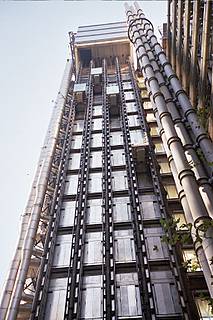 London Open
House day back in September was lovely and sunny. The Beetle was
not in the country to accompany Padmasana as she usually does, to
various places around central London to look around buildings
opened to the public for one or two days only, culminating in a
good fry up at the 24hr greasy spoon café in Smithfield. Next
year, maybe!
London Open
House day back in September was lovely and sunny. The Beetle was
not in the country to accompany Padmasana as she usually does, to
various places around central London to look around buildings
opened to the public for one or two days only, culminating in a
good fry up at the 24hr greasy spoon café in Smithfield. Next
year, maybe!
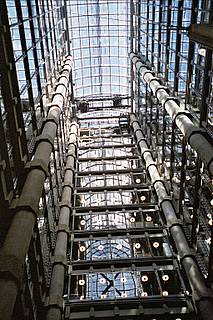
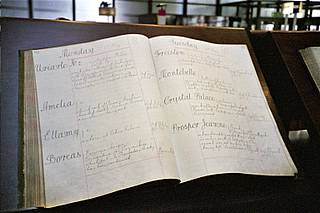 I then
walked along Fenchurch Street to number 60, where there were no
lines at the Vitro building, so was able to go straight up in the
lift to the 11th floor to see great views of the Tower of London,
the Gherkin and I could even see the London Eye.
I then
walked along Fenchurch Street to number 60, where there were no
lines at the Vitro building, so was able to go straight up in the
lift to the 11th floor to see great views of the Tower of London,
the Gherkin and I could even see the London Eye.

 The drive
ends with a huge rock arch which you drive through, up a hill and
park up a hill the other side.
The drive
ends with a huge rock arch which you drive through, up a hill and
park up a hill the other side.
 After they
had covered about 20 miles the bushranger suddenly
disappeared…The tracks led up to a wild cavern and into
it…and burst again into open day, and the route lay along a
rugged gorge for some three miles. Here the bushranger again
disappeared…All about were evidences of careful cultivation,
the bushranger having laid out quite a nice little farm.
Satisfied that he had run down his bird, Whalan retraced his
steps…When he returned home he told his brother Charles of the
strange country he had wandered into. 'I have been through
the Devil's Coachhouse,' he said. Next day a party was
made up, and with the aid of troopers McKeown was captured. His
hiding place was a huge hole in the mountain-side, known now as
McKeown's Hole…McKeown lived to return from a long term of
exile on Norfolk Island and to re-visit the scene of his former
exploits.”
After they
had covered about 20 miles the bushranger suddenly
disappeared…The tracks led up to a wild cavern and into
it…and burst again into open day, and the route lay along a
rugged gorge for some three miles. Here the bushranger again
disappeared…All about were evidences of careful cultivation,
the bushranger having laid out quite a nice little farm.
Satisfied that he had run down his bird, Whalan retraced his
steps…When he returned home he told his brother Charles of the
strange country he had wandered into. 'I have been through
the Devil's Coachhouse,' he said. Next day a party was
made up, and with the aid of troopers McKeown was captured. His
hiding place was a huge hole in the mountain-side, known now as
McKeown's Hole…McKeown lived to return from a long term of
exile on Norfolk Island and to re-visit the scene of his former
exploits.”

 Jeremiah
Wilson, a keen caver explored the end of the Elder Cave and in
1879 descended a shaft and rockpile to discover the Imperial
Cave. This was soon followed by the discovery of the “Left
Imperial” in 1880 (renamed the Chifley Cave in 1952 after
Prime Minister J.B Chifley). Development within the caves of
pathways and the protection of formations along with electric
lighting started in 1887. Even more caves were discovered in
1903, despite exploration being made only by candlelight. Today,
over 250,000 visitors make tours of the Jenolan caves.
Jeremiah
Wilson, a keen caver explored the end of the Elder Cave and in
1879 descended a shaft and rockpile to discover the Imperial
Cave. This was soon followed by the discovery of the “Left
Imperial” in 1880 (renamed the Chifley Cave in 1952 after
Prime Minister J.B Chifley). Development within the caves of
pathways and the protection of formations along with electric
lighting started in 1887. Even more caves were discovered in
1903, despite exploration being made only by candlelight. Today,
over 250,000 visitors make tours of the Jenolan caves.